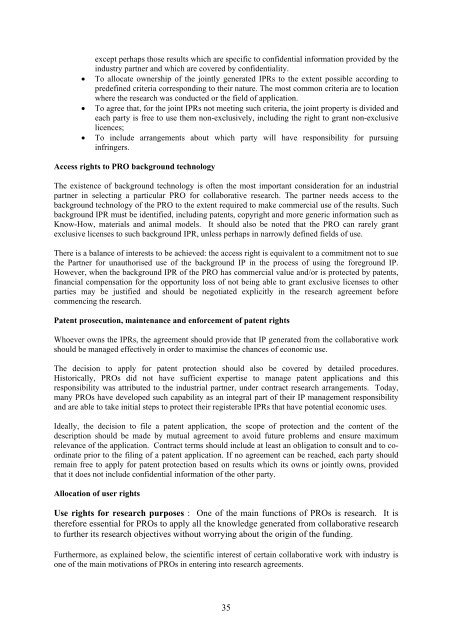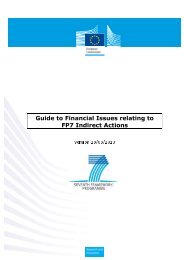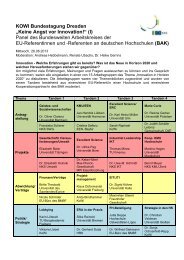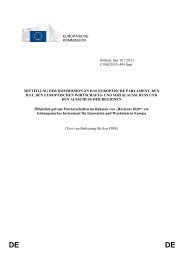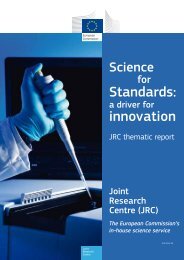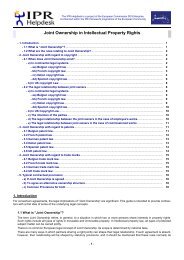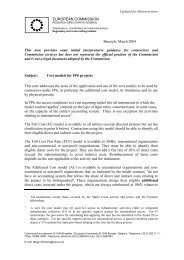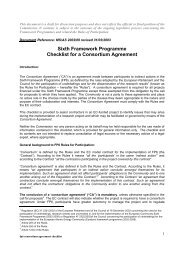Expert Group Report Management of Intellectual Property in ... - KoWi
Expert Group Report Management of Intellectual Property in ... - KoWi
Expert Group Report Management of Intellectual Property in ... - KoWi
Create successful ePaper yourself
Turn your PDF publications into a flip-book with our unique Google optimized e-Paper software.
except perhaps those results which are specific to confidential <strong>in</strong>formation provided by the<br />
<strong>in</strong>dustry partner and which are covered by confidentiality.<br />
• To allocate ownership <strong>of</strong> the jo<strong>in</strong>tly generated IPRs to the extent possible accord<strong>in</strong>g to<br />
predef<strong>in</strong>ed criteria correspond<strong>in</strong>g to their nature. The most common criteria are to location<br />
where the research was conducted or the field <strong>of</strong> application.<br />
• To agree that, for the jo<strong>in</strong>t IPRs not meet<strong>in</strong>g such criteria, the jo<strong>in</strong>t property is divided and<br />
each party is free to use them non-exclusively, <strong>in</strong>clud<strong>in</strong>g the right to grant non-exclusive<br />
licences;<br />
• To <strong>in</strong>clude arrangements about which party will have responsibility for pursu<strong>in</strong>g<br />
<strong>in</strong>fr<strong>in</strong>gers.<br />
Access rights to PRO background technology<br />
The existence <strong>of</strong> background technology is <strong>of</strong>ten the most important consideration for an <strong>in</strong>dustrial<br />
partner <strong>in</strong> select<strong>in</strong>g a particular PRO for collaborative research. The partner needs access to the<br />
background technology <strong>of</strong> the PRO to the extent required to make commercial use <strong>of</strong> the results. Such<br />
background IPR must be identified, <strong>in</strong>clud<strong>in</strong>g patents, copyright and more generic <strong>in</strong>formation such as<br />
Know-How, materials and animal models. It should also be noted that the PRO can rarely grant<br />
exclusive licenses to such background IPR, unless perhaps <strong>in</strong> narrowly def<strong>in</strong>ed fields <strong>of</strong> use.<br />
There is a balance <strong>of</strong> <strong>in</strong>terests to be achieved: the access right is equivalent to a commitment not to sue<br />
the Partner for unauthorised use <strong>of</strong> the background IP <strong>in</strong> the process <strong>of</strong> us<strong>in</strong>g the foreground IP.<br />
However, when the background IPR <strong>of</strong> the PRO has commercial value and/or is protected by patents,<br />
f<strong>in</strong>ancial compensation for the opportunity loss <strong>of</strong> not be<strong>in</strong>g able to grant exclusive licenses to other<br />
parties may be justified and should be negotiated explicitly <strong>in</strong> the research agreement before<br />
commenc<strong>in</strong>g the research.<br />
Patent prosecution, ma<strong>in</strong>tenance and enforcement <strong>of</strong> patent rights<br />
Whoever owns the IPRs, the agreement should provide that IP generated from the collaborative work<br />
should be managed effectively <strong>in</strong> order to maximise the chances <strong>of</strong> economic use.<br />
The decision to apply for patent protection should also be covered by detailed procedures.<br />
Historically, PROs did not have sufficient expertise to manage patent applications and this<br />
responsibility was attributed to the <strong>in</strong>dustrial partner, under contract research arrangements. Today,<br />
many PROs have developed such capability as an <strong>in</strong>tegral part <strong>of</strong> their IP management responsibility<br />
and are able to take <strong>in</strong>itial steps to protect their registerable IPRs that have potential economic uses.<br />
Ideally, the decision to file a patent application, the scope <strong>of</strong> protection and the content <strong>of</strong> the<br />
description should be made by mutual agreement to avoid future problems and ensure maximum<br />
relevance <strong>of</strong> the application. Contract terms should <strong>in</strong>clude at least an obligation to consult and to coord<strong>in</strong>ate<br />
prior to the fil<strong>in</strong>g <strong>of</strong> a patent application. If no agreement can be reached, each party should<br />
rema<strong>in</strong> free to apply for patent protection based on results which its owns or jo<strong>in</strong>tly owns, provided<br />
that it does not <strong>in</strong>clude confidential <strong>in</strong>formation <strong>of</strong> the other party.<br />
Allocation <strong>of</strong> user rights<br />
Use rights for research purposes : One <strong>of</strong> the ma<strong>in</strong> functions <strong>of</strong> PROs is research. It is<br />
therefore essential for PROs to apply all the knowledge generated from collaborative research<br />
to further its research objectives without worry<strong>in</strong>g about the orig<strong>in</strong> <strong>of</strong> the fund<strong>in</strong>g.<br />
Furthermore, as expla<strong>in</strong>ed below, the scientific <strong>in</strong>terest <strong>of</strong> certa<strong>in</strong> collaborative work with <strong>in</strong>dustry is<br />
one <strong>of</strong> the ma<strong>in</strong> motivations <strong>of</strong> PROs <strong>in</strong> enter<strong>in</strong>g <strong>in</strong>to research agreements.<br />
35


